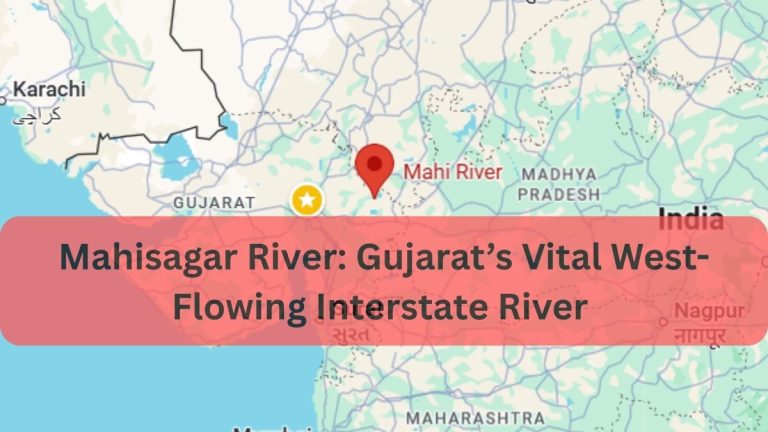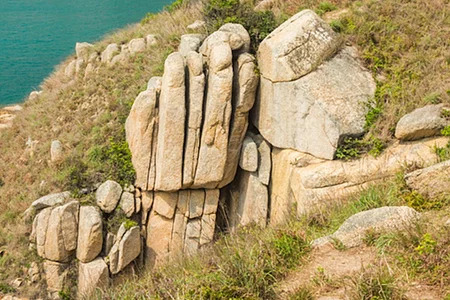How metamorphic rocks are formed?
Metamorphic rocks are formed as a result of the change of form of other rocks. The word transformation metamorphic has been derived from ‘metamorphose’ which means a change in form. Thus, metamorphic rocks are formed due to changes either in the form or composition of sedimentary rocks and igneous rocks.
“Metamorphic rocks include rocks that have been changed either in form or composition without disintegration.”
P. G. Worcester, A Textbook of Geomorphology, page 77, 1948.
It is necessary to mention here that at the time of metamorphism, there may be a complete change in the form of a rock, or the form of minerals or minerals may be changed into another form, or the rock may be crystallized or undergo re-crystallization, but there is no disintegration and decomposition of the rocks. When metaphoric rocks are metamorphosed again because of the high temperature and high pressure of overlying rocks; then this process is called re-metamorphism.
Sometimes, the form of the original rocks is greatly changed due to extreme metamorphism; therefore, it becomes difficult to know the original form of the rocks. Due to metamorphism, some rocks become harder than their original form, like ‘quartzite’ from ‘sandstone’ and marble from limestone. Thus, marble and quartzite are hard and more resistant than their original forms limestone and sandstone respectively. Similarly, the fossils in sedimentary rocks get destroyed because of high temperatures during metamorphism. This is the reason why fossils are often absent in metamorphic rocks.

Agents of metamorphism
Heat:
Heat is the most important agent for the metamorphosis of rock. When the country rocks come into contact with the magma, country rocks are melted by excessive heat. Then, molten rocks cooled, solidified, and recrystallized, altering their physical and chemical forms. The heat required for metamorphism is available from the lava or hot magma when it comes out through the vent or cracks during the volcanic eruption.
Pressure or Compression:
This process is related to the pressure of overlying rocks. As a result of orogenic movement, the rocks are folded to a significant depth. The pressure of the overlying rocks thus causes a change in chemical and physical properties and new rock is formed.
Solution:
This is the process of a chemical dissolution, in which various chemicals dissolved in groundwater react with country rocks below the earth’s surface. As a result of certain reactions, the chemical and physical forms of certain rocks change and formed a new rock.
Thus, a metamorphosed rock can be defined as a rock that was formed by a change in chemical and physical properties under the influence of high pressure, high temperature, and a chemical solution.

Types of Metamorphism
The process of metamorphism may be classified based on the following characteristics.
Based on the nature of agents
- Thermal metamorphism
- Dynamic metamorphism
- Hydro-metamorphism
- Hydro-thermal metamorphism
Based on place or area
- Contact metamorphism
- Regional metamorphism
Composite classification
- Contact or thermal metamorphism
- Dynamic and regional metamorphism
- Hydro-metamorphism
- Hydro-thermal metamorphism
Here will discuss composite classification of metamorphic rocks.
1. Contact Metamorphism
Contact metamorphism takes place when the mineral composition of the country rocks known as aureoles are changed because of the superheated magmas. This process of metamorphism is called contact metamorphism because metamorphism occurs when the country rocks come in contact with the magma that comes out through the vent of the volcano during a volcanic eruption. This process is also called thermal metamorphism because the rocks are changed their properties or composition due to the high temperature of the magma. For example, shale and sandstones transformed into marbles.
2. Regional Metamorphism
It refers to the process of alteration in the form of rocks over a large area. This type of metamorphism typically occurs deep within the earth’s crust and is associated with tectonic activity, such as mountain building. Regional metamorphism is also called as dynamic metamorphism because pressure plays an important role in the alteration of the form of the rocks. At the time of earth movement or tectonic activity, the sedimentary rocks are folded up and down because of compressional forces. The down-folded rocks (synclinal part) move down to such depth where the temperature is very high. As well as the increasing pressure of overlying rocks causes the melting, regrouping, and recrystallization of the rocks.
It is further divided into two subtypes
- Dynamic Regional Metamorphism: This occurs when the rocks are metamorphosed because of compressive forces and resultant high pressure due to convergent horizontal movements.
- Static Regional Metamorphism: This occurs when rocks are metamorphosed at greater depth because of intense high pressure and the weight of overlying rocks. For example, shale is converted into schist, coal is converted into anthracite, and anthracite into graphite.

3. Hydro-Metamorphism
It refers to the alteration of the composition of the rocks because of the different hydrological factors. For example
- Firstly, when the chemically active water passes through the country rocks, there occur some chemical changes in the rocks because of varied chemical reactions.
- Secondly, the storage of immense volumes of water in giant reservoirs employs high pressure on the underlying rocks and therefore the rocks are altered in their forms due to the pressure of overlying huge volumes of water.
This type of metamorphism is known as hydrostatic metamorphism.
4. Hydro-thermo Metamorphism
The negligible changes in the physical as well as the chemical composition of the rocks due to the weight and pressure of water mass and chemically active hot gases and water vapor are called hydro-thermal metamorphism. Hydro-thermo metamorphism may lead to the formation of unique geological features like hot springs and geysers.

Characteristics of Metamorphic Rocks
Metamorphic rocks have distinct characteristics that separate them from other rock types.
- Foliations: They are having foliation in which the mineral particles are aligned in a strip. The foliation resembles the stratification but often in a wave line.
- Cleavages: They are also common in this rock. They resemble foliation but are independent of the direction of stratification.
- Crystalline: They are crystalline rocks. Several minerals are concentrated in them. These rocks are known as a storehouse of minerals.
- Non-fossiliferous: They are non-fossiliferous rocks. Fossils are not found in these rocks.
- Texture: These rocks have a diverse and recognizable texture, such as a banded or foliated appearance because of the recrystallization of the minerals within the rocks.
- Hardness: These rocks are harder and more durable than their parent rocks, due to the recrystallization and compression that occurs during metamorphism.
- Color: Metamorphic rocks have a wide range of colors depending on the minerals present in them and the circumstances under which they were formed. For example, slate is typically dark gray or black, while marble is typically white or light colored.
- Porosity: Metamorphic rocks are typically less porous than their parent rocks because the recrystallization process during metamorphism closes any open spaces, making the rock denser.
You May Also Like





























